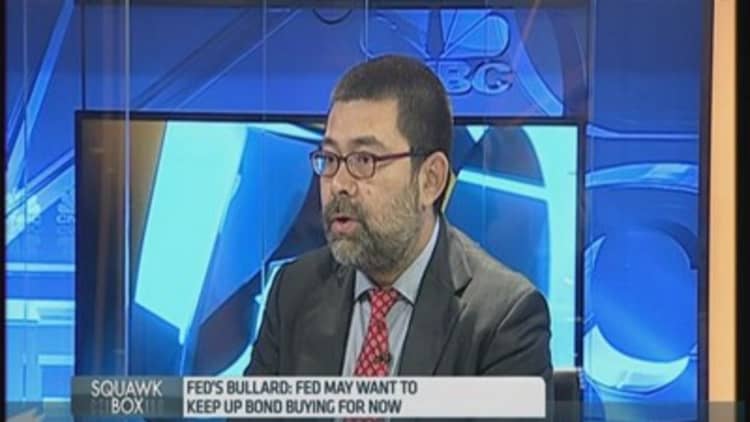"Bankruptcy? Repossession? Charge-offs? Buy the car YOU deserve," says the banner at the top of the Washington Auto Credit website. A stock photo of a woman with a beaming smile is overlaid with the promise of "100% guaranteed credit approval".
On Wall Street they are smiling too, salivating over the prospect of borrowers taking Washington AutoCredit up on its enticing offer of auto financing. Every car loan advanced to a high-risk, subprime borrower can be bundled into bonds that are then sold on to yield-hungry investors.
These subprime auto "asset-backed securities", or ABS, have, like a host of other risky assets, been beneficiaries of six years of quantitative easing by the US Federal Reserve, which is due to come to an end this week.
When the Fed began asset purchases in late 2008 the premise was simple: unleash a tidal wave of liquidity to force nervous investors to move out of safe investments and into riskier assets.
Read More
It is hard to argue that the tactic did not work; half a decade of low interest rates and QE appears to have sparked an intense scrum for riskier securities as investors struggle to make their return targets.
Wall Street's securitization machine has kicked back into gear to churn out bonds that package together corporate loans, commercial mortgages and, of course, subprime auto loans. At $359 billion sold last year, according to Dealogic data, issuance of junk-rated corporate bonds is at a record as companies take advantage of low rates to refinance debt and investors clamor to buy it.
The question now is whether the rebound in sales of risky assets will prove to be a toxic legacy of QE in a similar way that the popularity of subprime mortgage-backed securities was partly spurred by years of low interest rates before the financial crisis.
"QE has flooded the system with cash and you're really competing with an entity with an unlimited balance sheet," says Manish Kapoor of West Wheelock Capital. "This has enhanced the search for yield and caused risk appetites to increase."

Read More Correction possible, but QE end needed: Fed Fisher
The subprime auto loan market is a case in point. Lured by the higher returns on offer from investing in subprime auto ABS, investors have flocked to buy the securities. Sales of the bonds total $17.4 billion so far this year – on course to reach the highest annual level since the credit boom.
Washington Auto Credit,just one of many similar companies in a burgeoning industry, helps would-be car owners find financing for their vehicle purchases by connecting them with a growing crop of subprime car lenders. On its website, it lists Flagship Credit Acceptance, a relatively new auto lender backed by the private equity firm Perella Weinberg, as one of its partners.
Like other subprime auto lenders, Flagship has been able to grow its business by tapping strong investor demand for subprime auto ABS. So strong is that demand that Flagship has been marketing ABS with a "pre-funding" feature – in effect selling securitized bundles of auto loans before the loans have even been made.
Such pre-funding features were a hallmark of securitization markets before the crisis, when demand for residential mortgage-backed securities was so high that it outstripped supply of new loans. Now a similar dynamic appears in play, prompting concerns that investors' relentless search for yield will once again end poorly.
More from the Financial Times:
Big hedge funds suffer brutal October
Energy stocks fall as crude prices dip
Hess finds buyer for energy trading stake
Such features hint at a major worry over QE: that the liquidity unleashed by the Fed has stimulated demand in financial markets more than in the real economy.
"It's not the underlying economics that's driving things, it's central bank liquidity," says Matt King at Citigroup. Unconventional monetary policies are "very good at driving up asset prices but the trickle-through to things like inflation is very weak".
In larger markets there are worries over frothiness too. US regulators last year issued new guidelines to govern banks' lending to companies with weak balance sheets. Sales of these leveraged loans reached a record $607 billion last year, according to S&P CapitalIQ. Sales of collateralized loan obligations, which bundle together such loans,have helped fuel the boom, reaching a record $100 billion.
Still, proponents of such securitizations say they have history on their side. CLOs defaulted at arate of less than 0.5 per cent during the crisis. The housing bust taught many investors that Americans would sooner lose their homes than their cars, giving further impetus to post-crisis sales of subprime auto ABS. Crucially, issuance of securitizations is still far below levels seen in the run-up to the crisis.
Read MoreFed-driven 'Locomotive USA'
Yet there remains a lingering unease that investors are being herded into asset classes that may not be adequately compensating them for the risks involved. Some are already leveraging their portfolio and using derivatives to help amplify their returns during a period of unprecedented low interest rates.
"If you tell [investors]we're in a low-growth environment and add on top of that the central banks are your best friend . . . [they] will lever every single risk factor [they] can find," says Mohamed El-Erian, Pimco's former chief investment officer.

